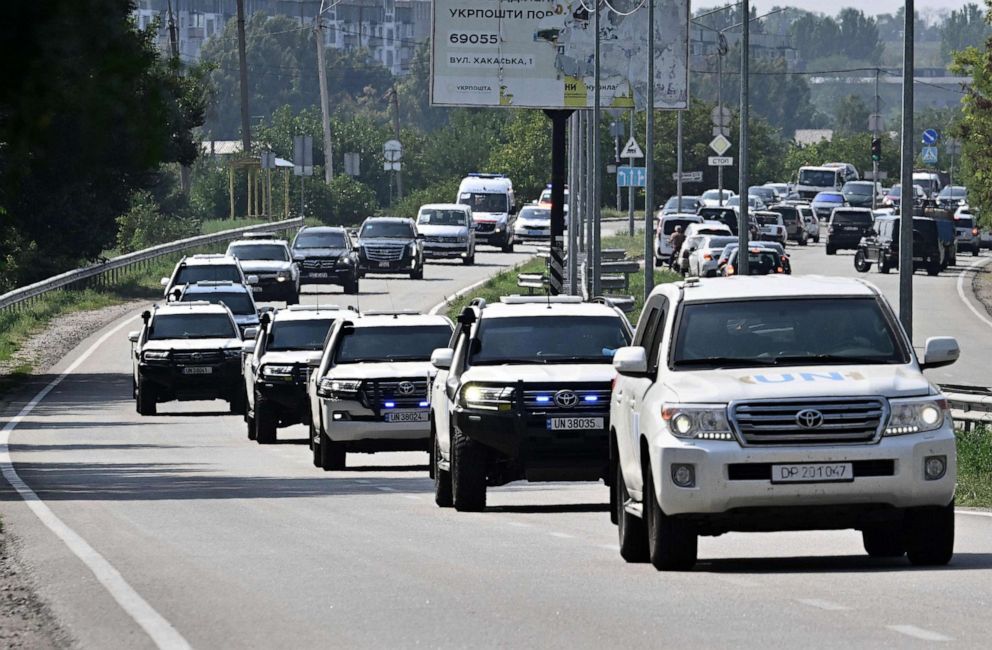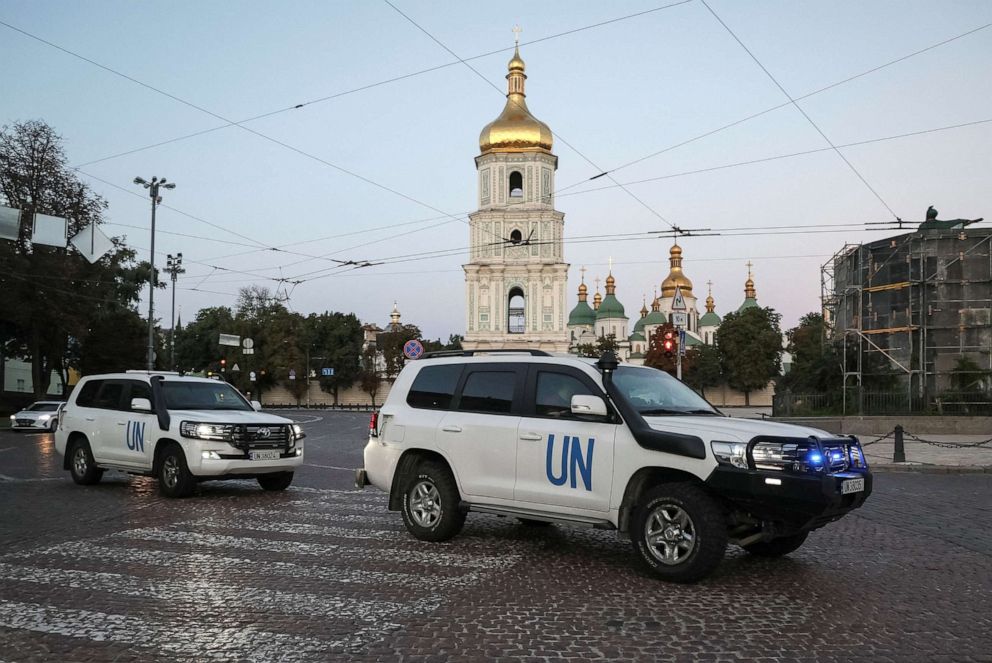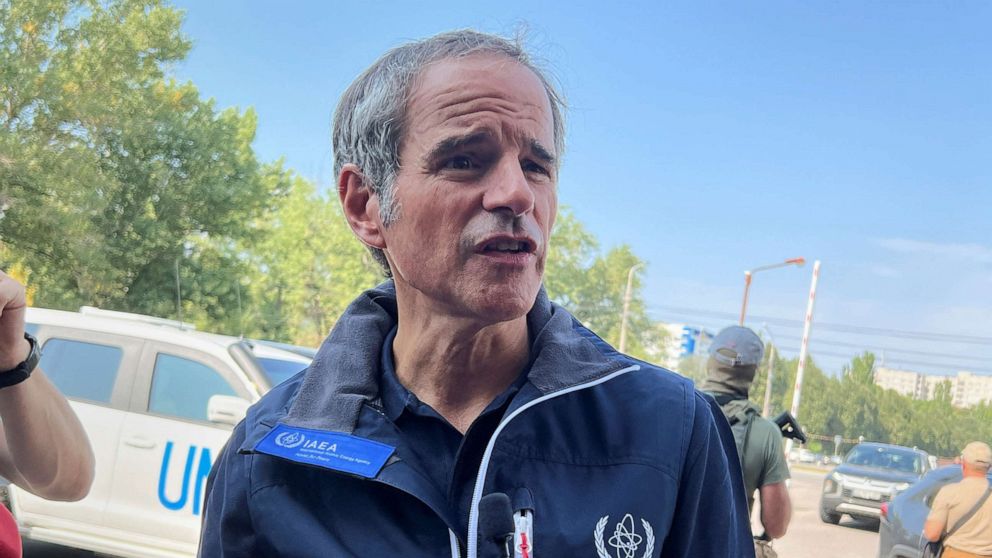Inspectors from the United Nations’ International Atomic Energy Agency are heading to the Zaporizhzhia nuclear power plant in southeastern Ukraine that has been shelled in the ongoing fight between Russian and Ukrainian forces, threatening a nuclear catastrophe in the region.
According to the IAEA, experts plan to “assess the physical damage to the ZNPP’s facilities, determine whether the main and back-up safety and security systems were functional and evaluate the staff’s working conditions, in addition to performing urgent safeguards activities on the site.”
The Zaporizhzhia nuclear power plant is the largest in Europe.

Members of an International Atomic Energy Agency (IAEA) inspection mission enter a hotel after their arrival in Zaporizhzhia, Ukraine, Aug. 31, 2022.
Genya Savilov/AFP via Getty Images
“We must protect the safety and security of #Ukraine’s and Europe’s biggest nuclear facility,” Rafael Grossi, director general of the International Atomic Energy Agency, said in a Twitter post this week.
Grossi, who is leading the mission, has long sought access to the nuclear power plant.
Russia and Ukraine have traded accusations of shelling at or near the site in recent weeks, fueling fears that the fighting could cause a nuclear disaster. The nuclear power plant has been occupied by Russian forces while still being operated by Ukrainian engineers since early May, according to the IAEA.
The nuclear power plant completely lost power on Thursday due to damage from nearby shelling, according to the IAEA. Two of the six reactors at the plant are currently operating from a single remaining power line.

UN vehicles transporting an International Atomic Energy Agency (IAEA) inspection team arrive in Zaporizhzhia, Aug. 31, 2022.
Genya Savilov/AFP via Getty Images
A secure off-site power supply from the electric grid and back-up power supply systems have kept the nuclear power plant running since the shut-off on Aug. 25, the IAEA said.
A lack of power poses a risk to the operation of the plant’s cooling systems, which are needed for the nuclear reactor and spent fuel ponds in the facility, Scott Roecker, nuclear materials security vice president at Nuclear Threat Initiative, told ABC News last week.
“And if there’s not active cooling of both of those facilities, it could lead to a reactor meltdown and a significant release of radiation,” Roecker said.
Amid the threat, officials in the region began distributing iodine tablets, which help block the absorption of radioactive iodine by the thyroid gland in a nuclear accident, to nearby residents, the Associated Press reported.
On Aug. 28, Ukrainian officials informed the IAEA of renewed shelling in recent days at the Zaporizhzhia nuclear power plant, but said all safety systems remained operational and there had been no increase in radiation levels, according to Grossi. Continued shelling raises the risk for a potential nuclear accident, experts say.

UN vehicles with members of International Atomic Energy Agency (IAEA) mission depart for the Zaporizhzhia nuclear power plant from central Kyiv, Ukraine, Aug. 31, 2022.
Gleb Garanich/Reuters
Shelling over the weekend hit two so-called “special buildings,” both located about 300 feet from a reactor. According to the IAEA, those buildings house facilities including water treatment plants, equipment repair shops or waste management facilities.
Grossi and his team arrived in the city of Zaporizhzhia on Wednesday and are expected to visit the nuclear power plant on Thursday for the first time. He told reporters during a press briefing that the IAEA mission aims to establish a permanent presence at the plant and that the initial phase would take days.
When asked if it was possible to demilitarize the site, Grossi told reporters that was “a matter of political will” and that his mission is to preserve Europe’s biggest nuclear power plant. He admitted it was “not a risk-free mission” and underlined that his team would be operating in Ukrainian sovereign territory but in cooperation with Russian forces.
Asked if he thought Russian troops would give his team full access, Grossi told reporters the IAEA was on a “technical mission” and that he was confident his team could work “on both sides.”
The IAEA said it seeks to bring clarity to the crisis with the mission, helping to address contradictory information about the status of the facility, its operation and the damage sustained.

IAEA Director General Rafael Mariano Grossi speaks with journalists after the International Atomic Energy Agency (IAEA) mission arrives in Zaporizhzhia, Ukraine Aug. 31, 2022.
Anna Voitenko/Reuters
Mikhail Ulyanov, Russia’s representative to the international organizations in Vienna, said on Wednesday that Russia welcomes the idea that IAEA experts could stay at Ukraine’s Zaporizhzhia nuclear power plant on a permanent basis.
Shortly after invading neighboring Ukraine on Feb. 24, Russian troops stormed the Zaporizhzhia nuclear power plant near the town of Enerhodar, on the banks of the Dnipro River. Ukrainian workers have been left in place to keep the plant operating, as it supplies electricity across the war-torn nation.




